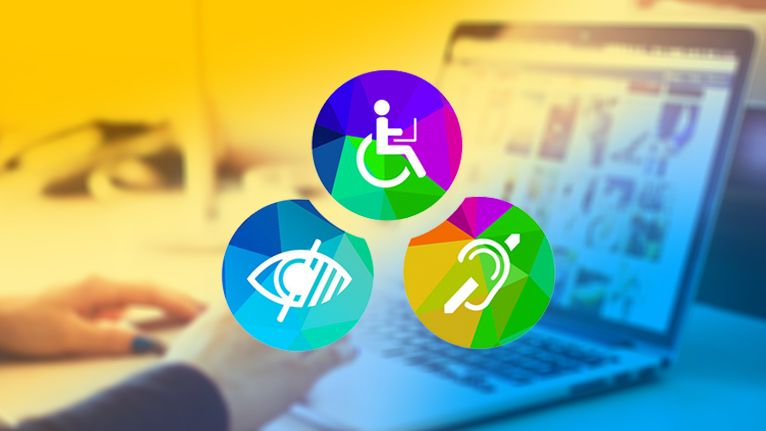
“Working From Home” sounds much less charming and appealing nowadays, which was impossible to imagine just a few months ago. This is likely a result of the fact that few of us have a choice in the matter.
As of March 17, nearly 90% of organizations have encouraged/required employees to work from home, according to Gartner.
However, despite our new reality, the work must go on. And this has caused us to come up with new ways to innovate, new ways to collaborate, and new ways to get stuff done while working from home. And perhaps one of the greatest virtual tools in our arsenal is the Remote Workshop.
In truth, we have been conducting remote workshops long before we started working from home to better work with our global offices and clients. However, with this being the new normal, we are taking advantage of the opportunity and turning our meetings into remote workshops for more effective collaboration – and a lot more fun if you work with the right virtual workshop tool.
Utilizing Mural, a virtual workshop whiteboard tool, and a variety of video conferencing applications and other virtual tools, we have successfully broken down the boundary between reality and the virtual world, overcoming the distances between us to focus on the project at hand even while working from home. That is why we decided to share our experience of using virtual workshop tools with you in hopes that you too will find success in your new remote reality of working from home.
Table of Contents
Simply click and start reading what you want!
Why Remote Workshops?
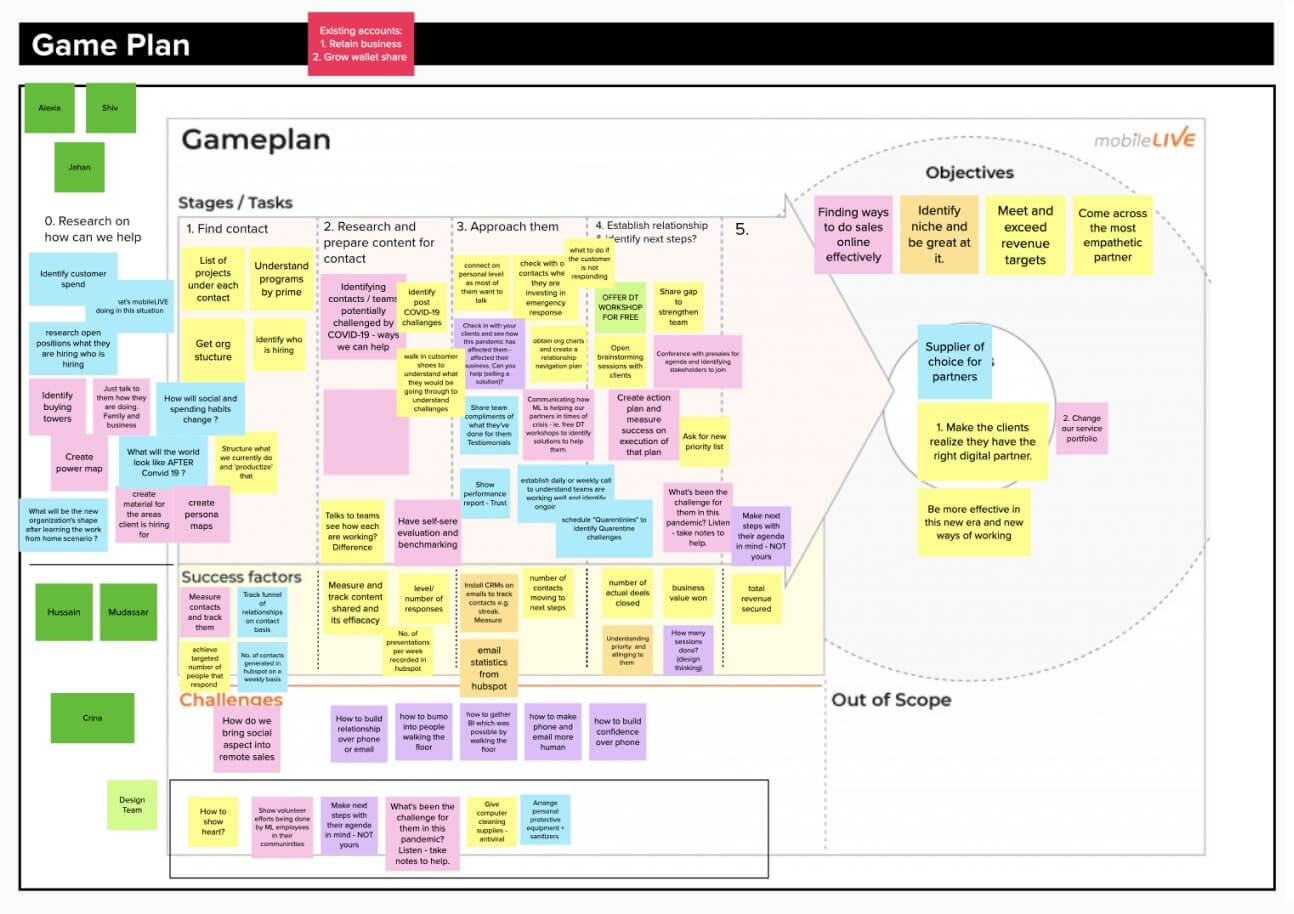
Bridging workshop facilitators and participants from physical space to online experience, Remote Workshops have emerged as a de facto way of working from home. Most of us are drowning in countless emails, phone calls, and video conferences, increasing stress and fatigue. A remote workshop conducted with the right virtual workshop tool could fill your day with some fun and playful activities while bringing a sense of achievement with visible outcomes from a collaborative brainstorming session.
In a remote workshop, a digital whiteboard is used to accommodate all types of media, i.e. images, mockups, presentation slides, GIFs, and even videos, which you easily drag-drop to share with your participants. As a facilitator, you can also define the viewport of your audiences by presetting the frame of each scene and their viewing sequence.
Thanks to keyboards, you won’t face the awkwardness of being unable to recognize someone’s handwriting. Plus, there is no need for tearing down or whipping off your sketch on the whiteboard after every session, giving you sufficient time and materials for cluster and stratified workshop outcomes.
Furthermore, a digital platform and a virtual workshop tool empowers you to create and publish reusable frameworks for different workshop types and/or activities. Frankly speaking, we love this feature of the virtual workshop tool as we no longer have to draw the empathy or prioritization map on blank sheets of paper before every workshop – phew! The time we saved has allowed us to focus more on our workshop planning and preparing.
The Challenges of Remote Workshop

Even though there is no shortage of reasons, why conducting a remote workshop can pose some challenges. This likely spawns from our collective inexperience in the transition from offline to online; however, these challenges are nothing that can’t be overcome while working from home.
Limitations in Facilities: In most physical workshops, we typically lock ourselves in a room with a huge screen to run the agenda and supporting slides, along with as many as whiteboards and unlimited Post-its for the collision and fusion of ideas. Whereas in an online environment, you’ll likely only have a laptop alongside your cup of coffee. That’s it! Although the boundaryless virtual whiteboard sounds cool, you are still limited by screen size. And while physical interaction and activity do have a direct correlation with creativity, it can be overcome with more creative activities incorporated in the remote workshops using virtual tools.
You could also find yourself in a nightmare if the network quality at home fluctuates or fails to support consistent communication between you, your colleagues and/or clients. Fortunately, Mural is a virtual workshop tool that gives you features like the ability to follow along, which helps solve this problem nicely.
Lack of In-person Contact: Human beings are social by nature. But social distancing and working from home is preventing much of the essential non-verbal communication we rely on, and perhaps none more than eye contact. We speak volumes through our eyes and can read a lot from looking at someone else’s. Sadly, you might have noticed in your recent video calls that there was hardly any direct eye contact, which could make you feel uncertain or lack confidence.

You might have also noticed the awkward silence when facilitating virtual meetings through virtual tools recently. Does this sound familiar: you try to keep your doubt and anxiety to a minimum, wondering whether the audience is following you, all while trying not to sound nervous. If so, don’t worry, you aren’t alone.
Less Control because of Limited Visibility: In a physical workshop, it’s easy for a facilitator to carefully observe participant’s reactions, while in a remote workshop, the facilitator is mostly interacting with people through a conference call or another virtual workshop tool (with potentially frustrating video quality no less ).
Many times an experienced facilitator can be clever on activity schedules and timeframes by judging participant reactions. This used to be the “killer skill” for a facilitator – to identify participant needs and make decisions quickly. However, these little signals become much more subtle through a screen while everyone is working from home. You may end up struggling to drive the conversation or control the timeline through the virtual tools you’re using.
Stress of Staying Focused: Physical workshops can run all day with a lunch break and a few short pauses throughout. On top of that, participants usually have some opportunities to shuttle between their seats and the whiteboard. These activities, although mundane, serve to keep participants’ bodies moving and necks stretched.
Now, the reality is everything is concentrated into a remote session where you and your participants are glued to your chairs and immersed in your laptop screens for 2 hours straight. It can be quite stressful to focus on a computer for long periods, not to mention the occasional distraction from kids or four-legged friends. Not to mention checking emails and messages at every opportunity.
Experts agree that the longer we’re in this remote working from home environment, the better we will adapt. So let us speed up that adaptation and show you how to overcome these challenges by conducting a productive remote workshop of your very own, using the right virtual tools for your team.
How to Conduct a Remote Workshop?

Our workshop process can be broken down into four stages – Planning for a workshop, Preparing for a workshop, Running a workshop, and After a workshop.
Below is a checklist we follow to ensure we have a successful workshop with productive and actionable outcomes:
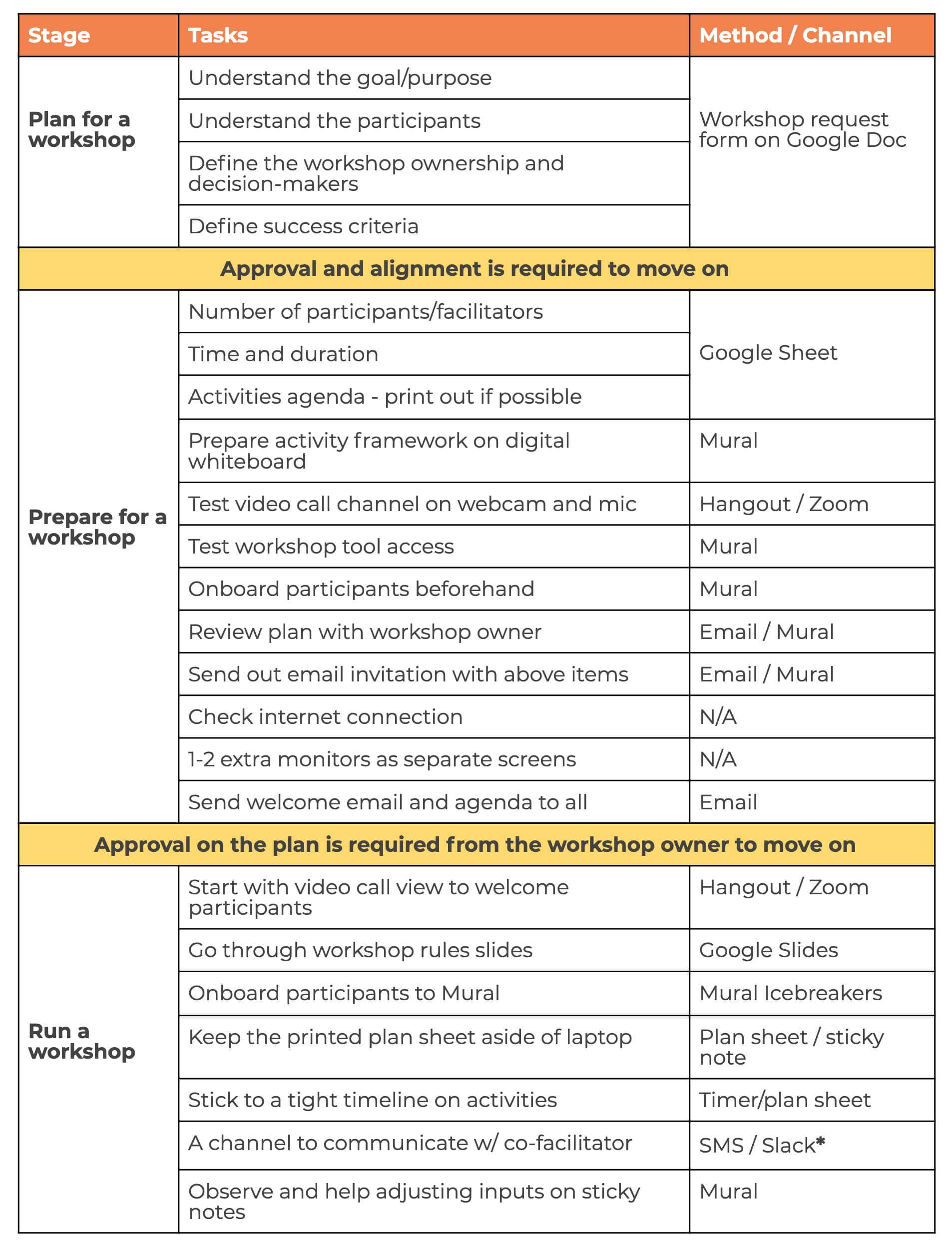
* The selection of communication tools is depending on the number of screens you use in the workshop. See details in the “Running Remote Workshop” section.
Now let us walk you through the process step by step:
Planning for a workshop: Typically, we will receive a notification from a member of our sales team or client, requesting a collaborative session to solve a particular issue or problem. We treat them as the owners of the workshop, and they serve as our go-to person for any clarification regarding the topic, desired outcome, or essential participants. The workshop plan must be signed off by the owner.

It’s necessary to know who you are speaking to in a workshop. You need to have a fair amount of knowledge about your participants, decision-makers, and their roles in their business. You also need a comprehensive understanding of the workshop’s purpose to plan out relevant activities. Ask the owner for a short description of the goals, expected outcomes and success criteria, and any specific requirements about the workshop.
To help with the planning we created a workshop brief, based on the NN Group template. The best practice is to book a 1-hour call with the workshop owner on his/her calendar and dedicate time to this task. We encourage you to craft the brief with the owner to align on the meeting intention and expected outcomes. Alternatively, it’s also acceptable if the owner prefers to work on his/her own, and come back to you for a consensus.
Preparing for a workshop: The number of participants is what you need to confirm with the workshop owner at this stage. This can have a significant impact on the types of activities you can plan, keeping in mind that smaller numbers work better for remote workshops.

The next step is to select which video conferencing tool you will use. Ensure that it adheres to corporate IT policies and/or any restrictions of team members, in the event of cross-company collaboration.
Like a physical workshop, use a spreadsheet to outline the activities. We usually use a Google Sheets template. Your plan should cover these fields – Step, Section, Duration, Group/Individual, Activity, and Details. As opposed to a physical workshop, we don’t need the Prop/Materials column.
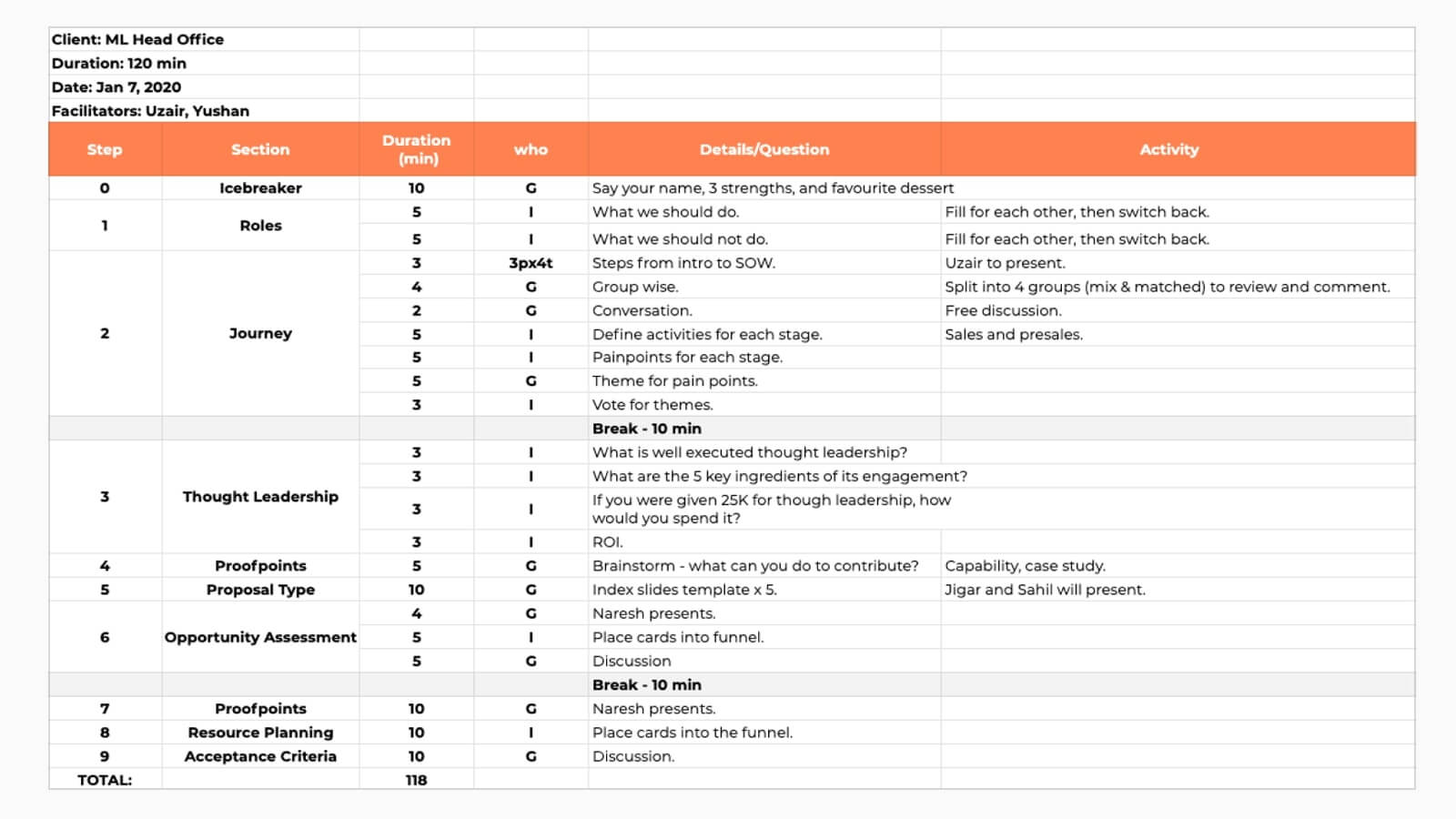
The real fun begins when you finally get to open the virtual whiteboard to create visual frameworks for the activities you just planned out. If this is the first remote workshop for most of your participants, we highly recommend you to create an onboarding activity with instructions and workshop online tools and tips. Send it out to your participants 3 days ahead of the scheduled workshop and ask them to practice and get familiar with the tool.
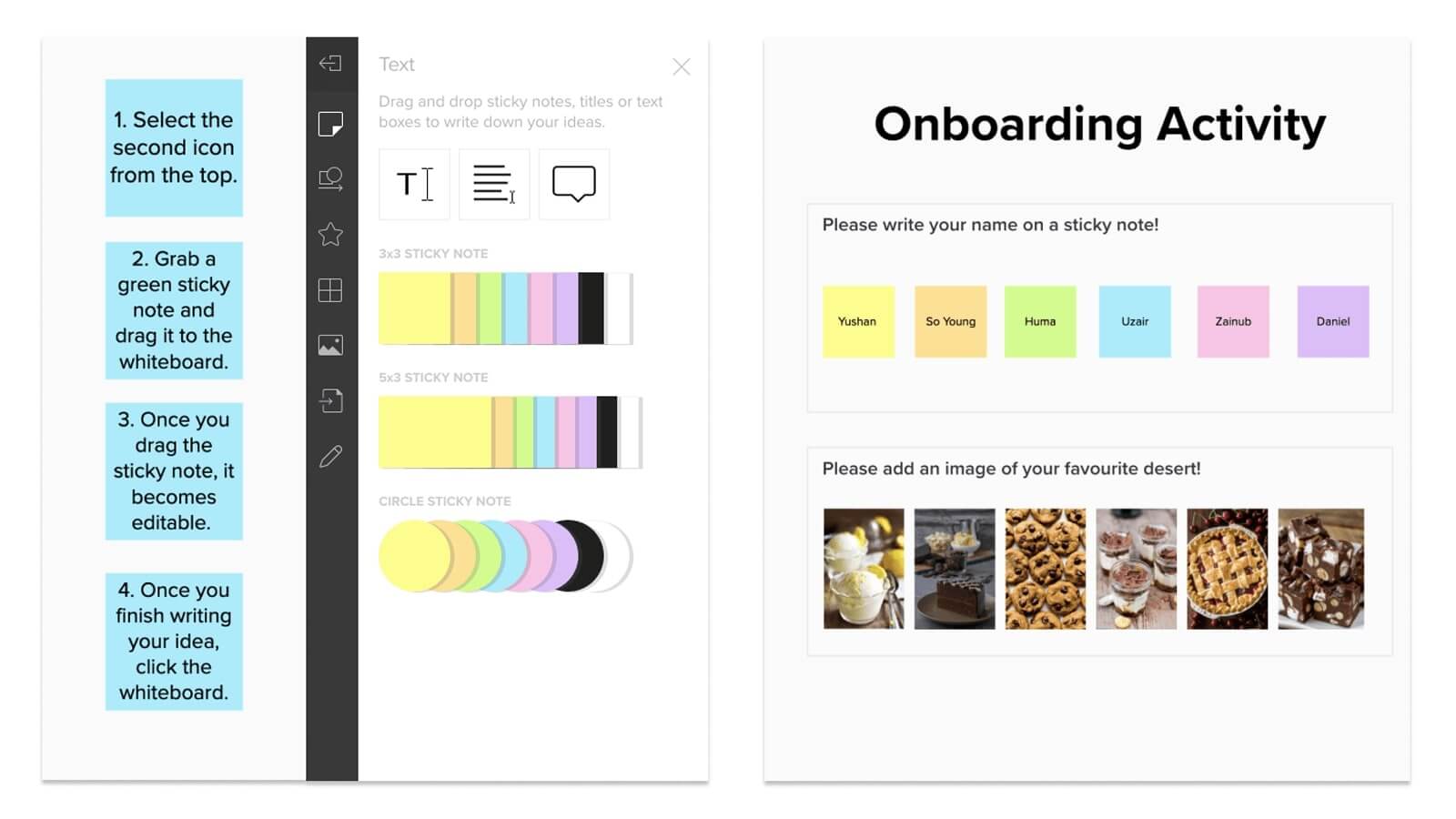
This will save you not only onboarding time, but you also get to test out the access from your participants’ side and troubleshoot before the actual workshop.
If this pre-workshop onboarding activity is not possible, we highly recommend budgeting time for an ice-breaker onboarding activity at the start of the workshop. Mural has several templates you can use.
Now that your activities are planned out, and everything looks great, we’d recommend booking another hour to walk the workshop owner through your plan. This is to cross-check if your workshop design is aligned with the objectives the owner had in mind. Don’t be afraid to be questioned: build trust by listening to his/her point of view, and explain your thought process behind designing it.
Your final workshop agenda must be signed off by the owner before the workshop.
Last but not least, we suggest you send out a welcome email to all participants, in which you introduce yourself as the facilitator and possibly your co-facilitator, explain the purpose and agenda of the session. You can also include the onboarding activity link you created for your remote tool and the workshop brief(preferably with the signature of the workshop owner).
Running a workshop: It’s workshop day! Jump on the video call 10 minutes early, so you have sufficient time to set things up and to greet participants who come early.

The first thing is to share the virtual whiteboard link with all participants. We usually copy-paste the link into the chat window, ask everyone to open up the link in another tab, keep the window handy, and then return to the call window.
Talk as clear as you can and try to look at the webcam while talking. This helps establish eye contact with your participants to feel like they are talking face to face with you. This makes you look more professional, sound confident, and appear well-prepared.
Stay in the video conference view for a couple of minutes at the beginning of the workshop. This allows the participants to see each other and have some quick huddles while waiting for others to join the bridge. Start talking warmly with your participants, and ask if they had a chance to go through the brief. You can reduce the time spent on explaining the workshop purpose and goal if you find that most of your participants have read the brief and are clear about the objectives.
The opening should not go beyond 5 minutes. Introduce the rules of the workshop, such as following the facilitator’s instructions, respecting timelines, and not judging others. Remote workshops must avoid free talk or call outs, as we all know what it sounds like when more than two people are talking at the same time. Guide the participants on how to signal you when they feel the need for a conversation.
In our workshop rules, we have a sub-section named Best Practice for Digital Sticky Notes, which is slightly different from sticky notes requirements in real life. For instance, we don’t need all-cap writings to be more recognizable in a digital format. We encourage the participants to type in more detailed inputs, rather than being overly-generic (see the example below).

You’re all set! Now it’s time to invite the participants to move to the virtual workspace window and start the activities. You should advise your participants to have both video calls, and workspace windows opened at the same time, so you get to see each other while working on the whiteboard. Our experience for single-screen users is to use 1/4 of the left side for video call view and the rest for the workspace on the right (see the example below). Interchange the two windows if you are left-handed.

We recommend an upgraded setup for facilitators who practice remote workshops more regularly. It’s a dual-screen arrangement that you can also recommend to the participants who have a spare monitor at home. An extra screen could provide relief to overloaded browser windows and help you observe the participants and comprehend their signals in time.
A second screen is also helpful when you need to communicate with your co-facilitator on some quick fixes on the plan but don’t want the participants to be aware. If you are not using a separate screen, set up a mobile channel with the co-facilitator on an instant messaging platform. Don’t forget to mute your cellphone or set it to vibration.
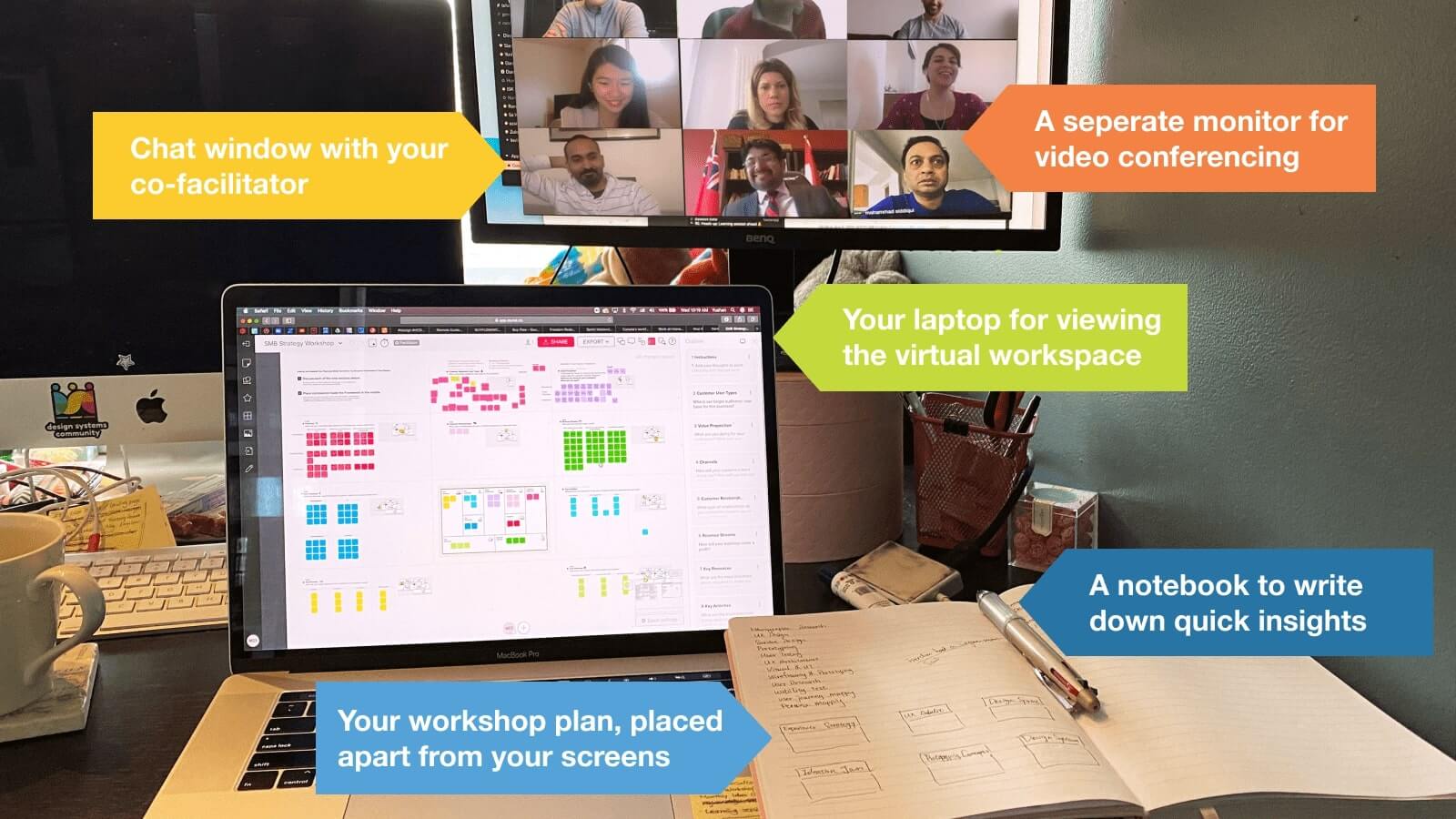
You should allow a short break every 1 or 1.5 hours, based on our experience. 5 min break for grabbing a drink or deal with emails, and another 5 min for a quick neck/back/eye exercise, which you will find tons of videos on YouTube.
Time flies in remote sessions, trust me. Work closely with the co-facilitator on holding the timeline tightly for each activity, by announcing the time left – by 1 minute, 30 seconds, respectively – and also ask if more time is needed when only 10 seconds left.
Always keep an eye on the time left in your workshop. You might end up tweaking the time-spent for several activities, so it is normal if there are still some tasks left with only 10 minutes left. At this point, remind your co-facilitator to speed up on the current activity and wrap it up within 2 minutes. You can spend another 2 minutes explaining that the time left doesn’t allow the rest of the activities and ask the participants whether they want to book another session or complete them individually after the workshop. Let them know the virtual workspace is accessible as long as the participants have the link.
The last 5 min will be given to the workshop owner to conclude the key takeaways from the session and the next steps. Wrap up the workshop by appreciating the participants for their valuable inputs and close the session on the video call.
After a workshop: Congratulations! You have just completed a remote workshop. Take a quick break, and then schedule a touchpoint with your co-facilitator to go over the findings and share insights while they are fresh. You can organize the insights and cluster results in a report (we usually use Google Slides for this). Don’t forget to export the entire workspace as a PDF file and attach it at the end of the report.
Send the report to all participants, along with a post-workshop survey, to collect feedback. These should ideally be sent out within a week to make sure the participants don’t wait too long for the report, and you get quality feedback while they still having a clear impression of the workshop.
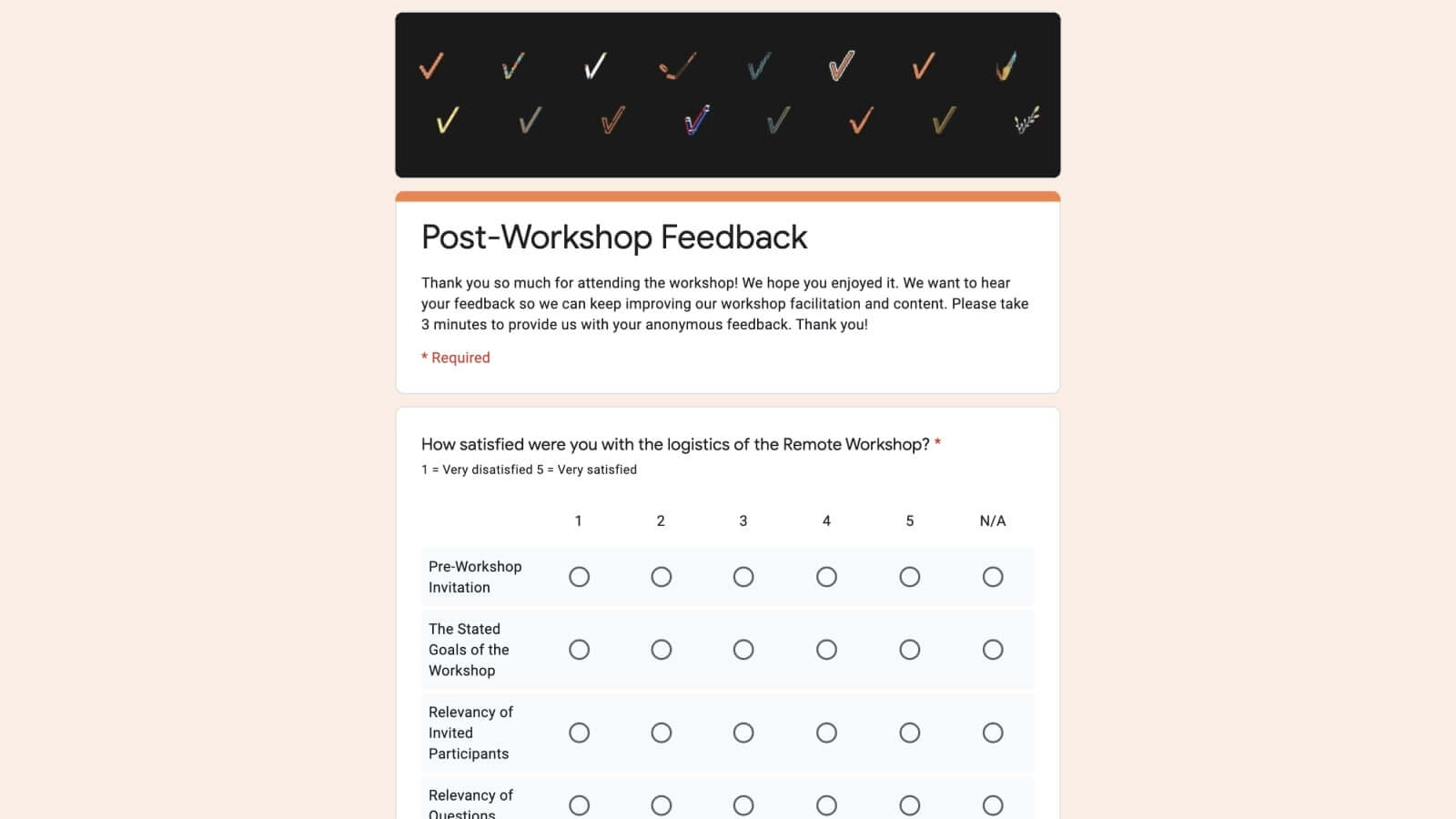
Take away
Today’s reality is that most of us don’t have a choice when it comes to working from home; however, that doesn’t mean we can’t make the most of it. With organizations Square and Twitter announcing that they will permanently allow their employees to work from home, it is likely remote working will stick around and become the new norm. We need to reconsider remote workshops as a regular way of working and this guide has hopefully made you that much more prepared to become early adopters and to best deal with this shift.



